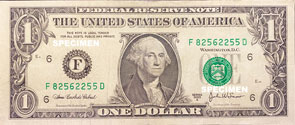Currency index
Advertisements
United States one dollar bill

Description:
Size: 155.956 x 66.294 mm
Paper type: 75% cotton, 25% linen
The United States one dollar bill ($1) is the most common denomination of US currency. The first president, George Washington,
painted by Gilbert Stuart, is currently featured on the obverse, while the Great
Seal of the United States is featured on the reverse. The one-dollar bill has
the oldest reverse design of all U.S. currency, while the two-dollar bill has
the oldest obverse design currently being produced. The obverse design seen
today on the one dollar bill debuted in 1963 when it first became a Federal
Reserve Note.
The inclusion of the national motto, "In God We Trust," on all currency was
required by law in 1955 and first appeared on paper money in 1957.
An individual dollar bill is also less formally known as a one, a
single, a buck, a bone, and a bill .
The Bureau of Engraving and Printing says the average life of a $1 bill in circulation
is 42 months before it is replaced because of wear. Approximately 29%
of all U.S. currency produced in 2018 were one-dollar bills.
How to tell if a one dollar bill is real?
Because the amount of time, effort, and money it takes to counterfeit a one dollar bill is unprofitable in most cases. There are isolated cases of $1 counterfeits. Here are 5 easy steps to detect fake one dollar bill or any note without special security features:- Feel the texture of the bill. People who handle money a lot of times, can identify a lower-quality counterfeit bill by touching it. Genuine currency has slightly raised ink that is produced in the intaglio printing process. You should be able to feel the texture of this ink, especially if you are holding a new dollar bill;
- Compare the bill with another of the same denomination and series. Hold the bill side by side with another bill.
- Look carefully at the printing quality. Real U.S. bank notes are printed using techniques that regular offset printing and digital printing (the most popular tools for all but the most sophisticated counterfeiters) cannot replicate. Look for blurry areas, especially in fine details such as around the borders--real bills have clear, unbroken borders--and on the Federal Reserve and Treasury seals, where the sawtooth points should be sharp and well-defined in genuine bills. Portraits in fake bills may appear dull, blurred, and flat, while in real currency, the portraits are sharp and contain very fine detailing.
- Tiny red and blue lines of U.S.currency are also manufactured in the paper mill from the beginning of each note or paper bill. An expert counterfeiter will print using what they call a "screen" process for each color. Unfortunately, under a magnifying glass, these threads are obvious because they seem to "stand up" on the legal paper, versus "lying down" on the counterfeiters printed papers.
- Examine the serial numbers. See if the serial numbers on a bill match. Counterfeit bank notes may have serial numbers that are not evenly spaced or that not perfectly aligned in a row. If you received more than one suspicious bill, see if the serial numbers are the same on both bills. If they are the same, then they are counterfeit notes.
Check this video of fake 1 dollar bill
In this video you can see a fake U.S 1 Dollar bill compared to a real one.
Sources:
uscurrency.gov
wikipedia.org













Follow currencyguide.eu